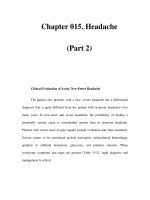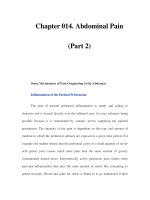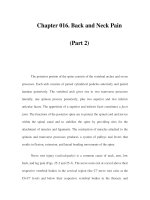Chapter 118. Infective Endocarditis (Part 2) doc
Bạn đang xem bản rút gọn của tài liệu. Xem và tải ngay bản đầy đủ của tài liệu tại đây (14.9 KB, 5 trang )
Chapter 118. Infective Endocarditis
(Part 2)
Prosthetic valve endocarditis arising within 2 months of valve surgery is
generally the result of intraoperative contamination of the prosthesis or a
bacteremic postoperative complication. The nosocomial nature of these infections
is reflected in their primary microbial causes: coagulase-negative staphylococci
(CoNS), S. aureus, facultative gram-negative bacilli, diphtheroids, and fungi. The
portals of entry and organisms causing cases beginning >12 months after surgery
are similar to those in community-acquired native valve endocarditis.
Epidemiologic evidence suggests that prosthetic valve endocarditis due to CoNS
that presents 2–12 months after surgery often represents delayed-onset nosocomial
infection. At least 85% of CoNS strains that cause prosthetic valve endocarditis
within 12 months of surgery are methicillin-resistant; the rate of methicillin
resistance decreases to 25% among CoNS strains causing prosthetic valve
endocarditis that presents >1 year after valve surgery.
Transvenous pacemaker lead– and/or implanted defibrillator–associated
endocarditis is usually nosocomial. The majority of episodes occur within weeks
of implantation or generator change and are caused by S. aureus or CoNS.
Endocarditis occurring among injection drug users, especially when
infection involves the tricuspid valve, is commonly caused by S. aureus strains,
many of which are methicillin-resistant. Left-sided valve infections in addicts have
a more varied etiology and involve abnormal valves, often ones damaged by prior
episodes of endocarditis. A number of these cases are caused by Pseudomonas
aeruginosa and Candida species, and sporadic cases are due to unusual organisms
such as Bacillus, Lactobacillus, and Corynebacterium species. Polymicrobial
endocarditis is more common among injection drug users than among patients
who do not inject drugs. The presence of HIV in the former population does not
significantly influence the causes of endocarditis.
From 5 to 15% of patients with endocarditis have negative blood cultures;
in one-third to one-half of these cases, cultures are negative because of prior
antibiotic exposure. The remainder of these patients are infected by fastidious
organisms, such as nutritionally variant organisms (now designated Granulicatella
and Abiotrophia species), HACEK organisms, and Bartonella species. Some
fastidious organisms that cause endocarditis do so in characteristic epidemiologic
settings (e.g., Coxiella burnetii in Europe, Brucella species in the Middle East).
Tropheryma whipplei causes an indolent, culture-negative, afebrile form of
endocarditis.
Pathogenesis
Unless it is injured, the endothelium is resistant to infection by most
bacteria and to thrombus formation. Endothelial injury (e.g., at the site of impact
of high-velocity blood jets or on the low-pressure side of a cardiac structural
lesion) causes aberrant flow and allows either direct infection by virulent
organisms or the development of an uninfected platelet-fibrin thrombus—a
condition called nonbacterial thrombotic endocarditis (NBTE). The thrombus
subsequently serves as a site of bacterial attachment during transient bacteremia.
The cardiac conditions most commonly resulting in NBTE are mitral
regurgitation, aortic stenosis, aortic regurgitation, ventricular septal defects, and
complex congenital heart disease. These conditions result from rheumatic heart
disease (particularly in the developing world, where rheumatic fever remains
prevalent), mitral valve prolapse, degenerative heart disease, and congenital
malformations. NBTE also arises as a result of a hypercoagulable state; this
phenomenon gives rise to the clinical entity of marantic endocarditis (uninfected
vegetations seen in patients with malignancy and chronic diseases) and to bland
vegetations complicating systemic lupus erythematosus and the antiphospholipid
antibody syndrome.
Organisms that cause endocarditis generally enter the bloodstream from
mucosal surfaces, the skin, or sites of focal infection. Except for more virulent
bacteria (e.g., S. aureus) that can adhere directly to intact endothelium or exposed
subendothelial tissue, microorganisms in the blood adhere to sites at NBTE. If
resistant to the bactericidal activity of serum and the microbicidal peptides
released locally by platelets, the organisms proliferate and induce a procoagulant
state at the site by eliciting tissue factor from adherent monocytes or, in the case of
S. aureus, from monocytes and from intact endothelium. Fibrin deposition
combines with platelet aggregation, stimulated by tissue factor and independently
by proliferating microorganisms, to generate an infected vegetation. The
organisms that commonly cause endocarditis have surface adhesin molecules,
collectively called microbial surface components recognizing adhesin matrix
molecules (MSCRAMMs), that mediate adherence to NBTE sites or injured
endothelium. Fibronectin-binding proteins present on many gram-positive
bacteria, clumping factor (a fibrinogen- and fibrin-binding surface protein) on S.
aureus, and glucans or FimA (a member of the family of oral mucosal adhesins)
on streptococci facilitate adherence. Fibronectin-binding proteins are required for
S. aureus invasion of intact endothelium; thus these surface proteins may facilitate
infection of previously normal valves. In the absence of host defenses, organisms
enmeshed in the growing platelet-fibrin vegetation proliferate to form dense
microcolonies. Organisms deep in vegetations are metabolically inactive
(nongrowing) and relatively resistant to killing by antimicrobial agents.
Proliferating surface organisms are shed into the bloodstream continuously.
The pathophysiologic consequences and clinical manifestations of
endocarditis—other than constitutional symptoms, which probably result from
cytokine production—arise from damage to intracardiac structures; embolization
of vegetation fragments, leading to infection or infarction of remote tissues;
hematogenous infection of sites during bacteremia; and tissue injury due to the
deposition of circulating immune complexes or immune responses to deposited
bacterial antigens.









